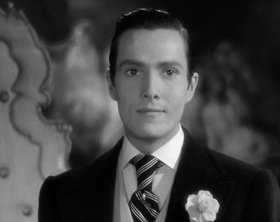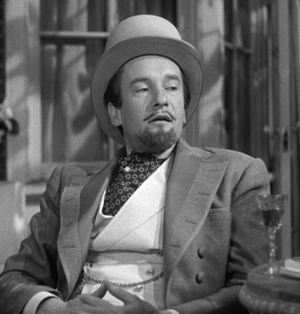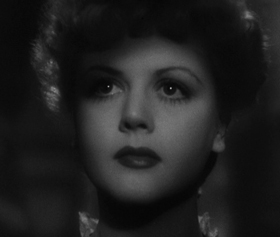| Release List | Reviews | Price Search | Shop | Newsletter | Forum | DVD Giveaways | Blu-Ray/ HD DVD | Advertise |
| Reviews & Columns |
|
Reviews DVD TV on DVD Blu-ray International DVDs Theatrical Reviews by Studio Video Games Features Collector Series DVDs Easter Egg Database Interviews DVD Talk TV DVD Talk Radio Feature Articles Columns Anime Talk DVD Savant HD Talk Horror DVDs Silent DVD
|
DVD Talk Forum |
|
|
| Resources |
|
DVD Price Search Customer Service #'s RCE Info Links |
|
Columns
|
 |
The Picture of Dorian Gray |

|
The Picture of Dorian Gray Warner Home Video 1945 / B&W with Color inserts / 1:37 flat full frame / 110 min. / Street Date October 7, 2008 / 19.97 Starring George Sanders, Hurd Hatfield, Angela Lansbury, Donna Reed Cinematography Harry Stradling Art Direction Cedric Gibbons, Hans Peters Film Editor Ferris Webster Original Music Herbert Stothart Produced by Pandro S. Berman Written and Directed by Albert Lewin |
MGM didn't make very many horror films, but two of its 1940s pictures were prestige "A" efforts. Metro good taste and heavy-handed moralizing pretty much neuters 1941 Dr. Jekyll and Mr. Hyde. Four years later, Albert Lewin's The Picture of Dorian Gray is a high-toned adaptation of Oscar Wilde's strange tale of a man whose vices are reflected not in his face, but in a haunted portrait. Straight from his acclaimed, highly intelligent The Moon and Sixpence, writer-director Lewin infuses Dorian Gray with murky undercurrents of forbidden vices. Depending on one's taste, the picture is a fine example of cinematic discretion in the Val Lewton style, or a cultured pretzel that must twist and turn to avoid its own subject matter.
The Picture of Dorian Gray was a big success for Albert Lewin and MGM. Oscar Wilde's famous horror premise begins with the meeting of the cynical Lord Henry Wotton (George Sanders) and the beautiful, innocent Dorian Gray (Hurd Hatfield) on the day that Gray's portrait is completed. Wotton poisons Gray's mind with the notion that the only way to truly live is to seize all sensation within reach, with no regard for others. To Gray's horror, a wish he makes comes true: he will be untouched by time while his portrait ages in his stead. Hidden in the attic, the picture reflects all of Gray's moral crimes. As his contemporaries grow old, Dorian Gray remains as beautiful as he ever was.

As delivered by the velvet lizard George Sanders, Lord Wotton's constant droll observations are both hateful and witty: "There's only one way to get rid of temptation, and that's to yield to it." "Forgive me for the intelligence of my argument; I'd forgotten that you were a Member of Parliament." In Lewin's symbol-ridden vision, Wotton is seen chloroforming a butterfly, which dissolves to the "preserved" visage of Dorian Gray. The handsome Hurd Hatfield is directed to be not the smiling young man of the story, but a rather sinister figure. Gray's mask-like face seems to lack the spark of life, His smooth features remind us of the partially-finished pod people in Invasion of the Body Snatchers. What Donna Reed's underwritten Gladys Hallward sees in Dorian is unclear. The only interpretation that absolves Dorian of blame is that Lord Wotton is The Devil. As pointed out by Steve Haberman in his commentary, Wotton is really just a Devil's Advocate.

To satisfy the Production Code, Lewin trots out every manner of narrative evasion and ellipsis. Almost all of Dorian Gray's crimes are referenced through hints and gossip in Cedric Hardwicke's voiceover. The images show next to nothing, forcing us to fill in Gray's moral crimes from our own sordid imaginations. A female party guest hides her face when Dorian enters, indicating some unspoken shame at his hands. Gray is seen ascending the back stairs in a barroom; the presence of dwarf Angelo Rossitto suggests even more perverse activity upstairs. Beyond his one stabbing murder, the rest of Dorian's on-screen criminal behavior is limited to drinking in grog shops and walking in the fog. Is this civilized horror, or a radio show?
But other content is not as vague. For its year the film is rather daring in suggesting homosexual vibes in the Wotton/Gray relationship. Lord Wotton dotes on Gray as if conducting a social experiment. Later in the story, Dorian blackmails a man who has become a miserable wreck because of their previous association, and we're told that another male friend has killed himself over similar pangs of guilt. It's difficult to picture anything but homosexual relations as the unspoken subject. But Dorian is never shown having a good time with his vices, a choice more likely than not mandated by The Code. Like Wilde's pickled butterfly, The Picture of Dorian Gray lacks life. The dead-eyed Hurd Hatfield moves joylessly through polished MGM hallways; London's wealthy are seen only in fancy gowns and formal dinner attire, like figures in a waxworks.
The film's redeeming sequence is Dorian's romance with the "little bird" music hall singer Sybil Vane. To convince Gray that human morality is a myth -- and to keep the younger man for himself? -- Wotton challenges Dorian to submit his sweetheart Sybil Vane (Angela Lansbury) to a cruel, unfair test of virtue. Wotton's rigged experiment results in tragedy, that in turn launches Gray on his secret voyage of debauchery and vice. At only twenty years of age Angela Lansbury makes Sybil both vulnerable and cautious. Sybil is well aware that her mother and manager have hung her out like bait hoping that she'll find a rich "sponsor". The singer blooms with the promise of Dorian's devotion, only to be dealt a crushing disillusion. Dorian is as much a patsy of Wotton's cynical "test" as is poor Sybil, but the fact that he didn't reject Wotton's scheme indicates that his character was unworthy to begin with. The victimization of Sybil is the most effective "horror" in the movie. 1

Most everything else in the film is told at the remove of the past-tense narration. To emphasize a supernatural connection, Lewin features a statuette of the Egyptian cat in many "meaningful" compositions. Dorian Gray personally kills one witness, but other inconvenient people die by accident or suicide, as if Dorian had supernatural helpers covering up his evil past, Mr. Arkadin- style. The supernatural explanation seems weak, because Dorian's original "wish" was little more than a thoughtless daydream. Fate, or the Cat Deity, doesn't even play fair with Dorian. The deal was that the portrait would reflect Gray's age, not his interior moral state. The story stumbles on the Victorian principle that our faces will always be a true reflection of our souls. 2
The Technicolor inserts of the gory portrait caused a buzz among audiences; its surface seems to be painted with bloody entrails. The portrait records all of the horror that the rest of the movie scrupulously avoids. After all the polite restraint, The Picture of Dorian Gray doesn't leave much room for moral ambiguity. Albert Lewin's search for high art is compromised by the censor edict that all immoral behavior be countered with an endorsement of religious values. At the fade-out, Lord Wotton does a complete character flip-flop, asking for heaven's mercy. The last image is of a poetry verse, in a book displayed like a fancy Bible.
Warners' DVD of The Picture of Dorian Gray presents the famous high-class horror film in an utterly spotless transfer. Angela Lansbury's delicate voice sounds much better than in older television copies. The fully restored Technicolor inserts not only jolt us with their gory reds, the old splice jumps are gone as well.
The extras include a trailer and two Oscar winning shorts, Stairway to Light and the Tom & Jerry cartoon Quiet Please! But fans will want to give a listen to the commentary with Angela Lansbury, hosted by Steve Haberman. Haberman compares the film to the novelette -- there are many interesting differences -- while Ms. Lansbury shares detailed recollections about most everyone associated with the production, including director Lewin. She voices sympathy for Hurd Hatfield, who she says was directed to keep his face still and mask-like in all scenes. Lewin gave Hatfield inflexible line readings, locking him into the rigid performance we see on the screen.
On a scale of Excellent, Good, Fair, and Poor,
The Picture of Dorian Gray rates:
Movie: Good +
Video: Excellent
Sound: Excellent
Supplements: Trailer, two short subjects, commentary with Angela Lansbury and Steve Haberman
Packaging: Keep case
Reviewed: October 5, 2008
Footnotes:
1. Interestingly, writer Vladimir Nabokov seems to have borrowed the name Sybil Vane for his haunting -- or haunted -- 1951 short story The Vane Sisters. There's no explicit connection, but one tale always reminds me of the other.
Return
2. The movie Groundhog Day is really the inverse of the same concept. Trapped in a state in which he will never age, Bill Murray tires of selfish pranks and improves himself instead. It's too bad that nobody painted magical portraits of Mohandas Gandhi, Abraham Lincoln or John Lennon.
Return
Reviews on the Savant main site have additional credits information and are more likely to be updated and annotated with reader input and graphics.
Review Staff | About DVD Talk | Newsletter Subscribe | Join DVD Talk Forum
Copyright © MH Sub I, LLC dba Internet Brands. | Privacy Policy
Subscribe to DVDTalk's Newsletters
|
| Release List | Reviews | Price Search | Shop | SUBSCRIBE | Forum | DVD Giveaways | Blu-Ray/ HD DVD | Advertise |





